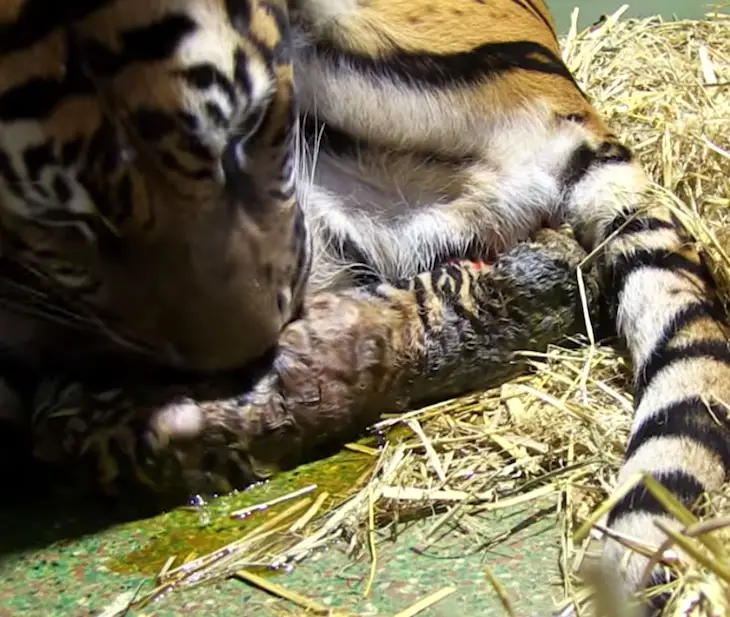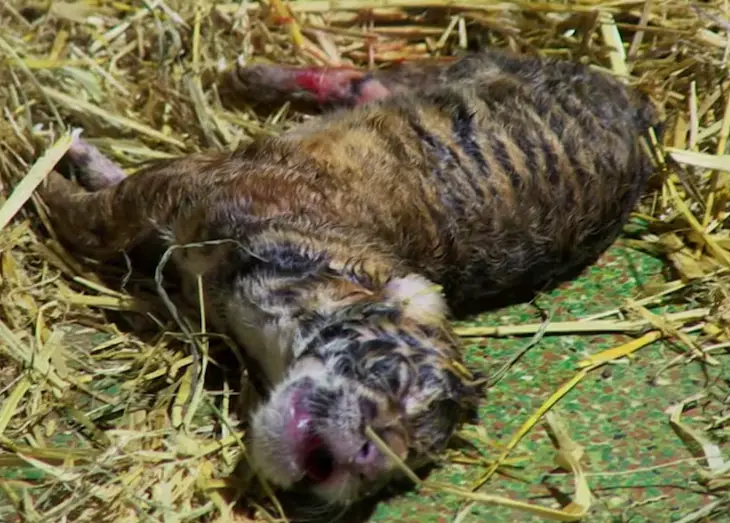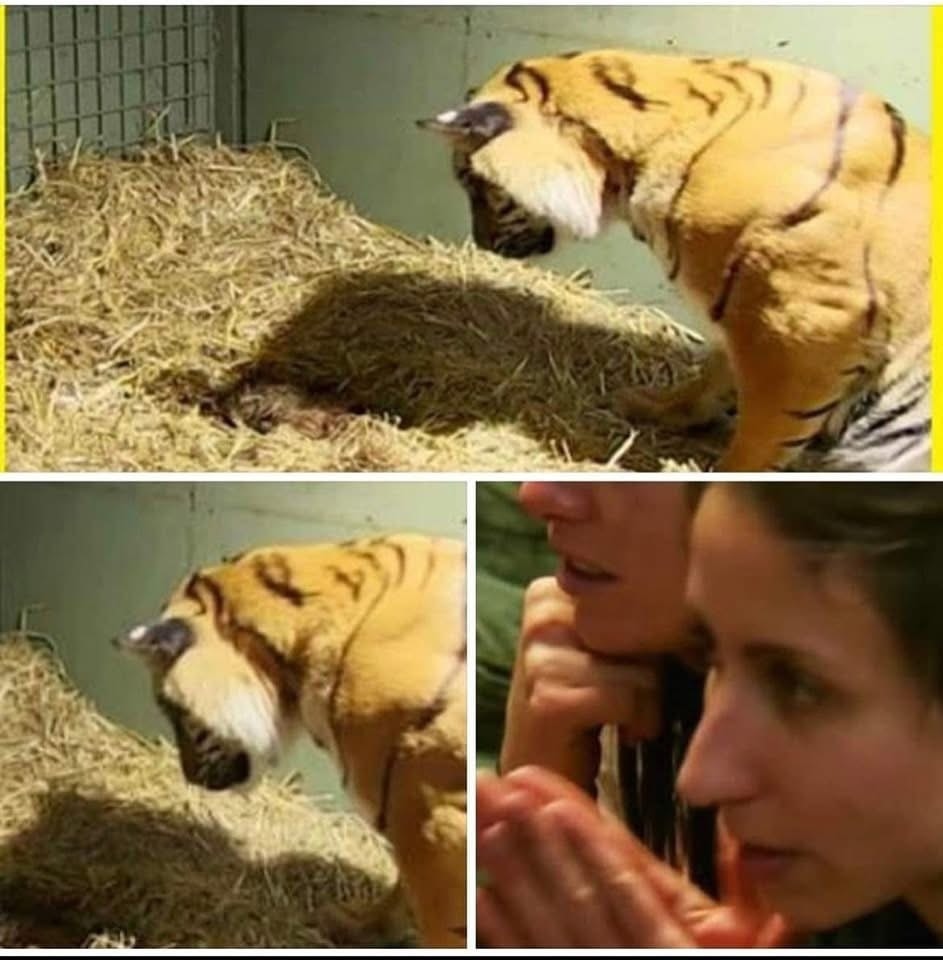A Story of Instinct, Resilience, and the Miracle of Life
It began as a moment of quiet anticipation inside the Australia Zoo. The caretakers stood by, hearts racing but hands steady, watching one of nature’s most magnificent creatures—a Sumatran tiger named Kaitlyn—prepare to give birth for the very first time. Cameras were rolling, capturing what was expected to be a joyous moment for conservation and animal lovers worldwide.
But when the first cub arrived, something was terribly wrong. The tiny newborn wasn’t moving. For a few tense seconds, it seemed that this miracle of life might not find its breath.
And then, something extraordinary happened—something that left the caretakers, scientists, and viewers across the world in awe.
Kaitlyn, guided by an ancient maternal instinct, leaned in close to her cub and began licking him gently yet urgently. It was not panic, but purpose. Her actions, rooted in millions of years of evolution, worked like nature’s own form of medicine. Within moments, the lifeless cub gasped for air, taking his first breath as the mother continued to nudge and clean him.
The team at Australia Zoo breathed again too. What they had just witnessed wasn’t just a birth—it was a reminder of the unbreakable bond between instinct and survival.

The Rare and Precious Sumatran Tiger
Guardians of the Jungle
Sumatran tigers (Panthera tigris sumatrae) are among the world’s most endangered big cats. Native to the dense tropical forests of Sumatra, Indonesia, their population is estimated to be only 400 to 600 in the wild. These elusive creatures are smaller than their mainland relatives, adapted for stealth in thick jungle terrain, with unique stripes and piercing amber eyes that tell stories of ancient wilderness.
The species faces ongoing challenges—habitat loss, environmental pressures, and declining prey populations. This makes every new birth, especially in captivity, a vital step toward preserving their lineage. Zoos like Australia Zoo, in partnership with global conservation organizations, play a crucial role in protecting and reviving these populations through breeding programs and reintroduction initiatives.
Kaitlyn’s delivery, therefore, wasn’t just another moment in zoo life—it was a significant milestone in the global effort to save an entire species from the brink of extinction.

When Instinct Becomes a Lifeline
Nature’s Unspoken Intelligence
Animal mothers, whether in the wild or under human care, often display remarkable awareness during childbirth. In Kaitlyn’s case, when the first cub appeared unresponsive, her immediate reaction—to lick and stimulate—was not taught but inherited.
This instinctive behavior serves several biological purposes:
-
Stimulation of Breathing: The mother’s licking motion clears the newborn’s airways, encouraging breathing and oxygen flow.
-
Circulation Boost: The pressure and warmth from licking help activate the cub’s circulation and muscle tone.
-
Bond Formation: Through touch and scent, the mother establishes a deep emotional and biological connection.
Such moments reveal nature’s extraordinary precision—how survival mechanisms are woven seamlessly into the fabric of life. While humans use advanced medical tools to assist in childbirth, many animal species rely purely on instinct, demonstrating how evolution equips mothers with the wisdom to protect and nurture their young.

The Science of Maternal Behavior
From Hormones to Heart
Biologists often describe maternal instinct as a powerful mix of biology and emotion. In mammals, the hormone oxytocin, sometimes called the “love hormone,” plays a central role during childbirth and bonding. It encourages uterine contractions, milk production, and emotional attachment—all of which ensure the offspring’s survival.
In tigers, maternal care is especially intense during the first few weeks after birth. Cubs are born blind and completely dependent on their mothers. A Sumatran tiger mother will nurse, clean, and guard her young relentlessly, often without leaving the den for several days.
The scientific wonder of Kaitlyn’s reaction is that she displayed these behaviors instantly, without prior experience. Her brain, guided by instinct and hormonal cues, recognized her cub’s distress and responded with precision that no amount of human intervention could replicate.
For caretakers, it was a lesson in humility—a reminder that while humans can assist and protect, nature often knows exactly what to do.
Cultural Symbolism: Tigers and the Power of Life
Majesty Across Myths and Civilizations
Throughout history, tigers have been revered as symbols of strength, courage, and guardianship. In Indonesian and Southeast Asian folklore, the tiger is seen as both a protector and a spirit guide, representing balance between power and grace. Some legends speak of tigers as keepers of the forest—creatures that maintain harmony between humans and nature.
In Chinese mythology, the tiger stands as one of the Four Symbols, representing the West and embodying the element of metal. It is often associated with protection, vitality, and life force. Similarly, in Indian culture, the goddess Durga rides a tiger as a sign of divine strength and maternal protection.
Against this backdrop, Kaitlyn’s story transcends biology. It becomes almost mythic—a living expression of the timeless themes of motherhood, courage, and rebirth. Her act of reviving her cub mirrors these ancient tales where life triumphs through instinct and love.
Modern Conservation: Hope Through Action
Australia Zoo’s Legacy of Care
Founded by the late Steve Irwin and his family, Australia Zoo has long been a beacon for wildlife preservation. Their tiger breeding program focuses not only on sustaining healthy genetic lines but also on educating the public about the importance of conservation.
Kaitlyn’s successful birth serves multiple purposes:
-
Biodiversity Preservation: Every cub born in captivity strengthens the species’ genetic diversity.
-
Educational Impact: Such moments inspire millions to understand and support endangered species.
-
Emotional Connection: Seeing the maternal bond firsthand fosters empathy—an essential driver for conservation efforts.
Zoo caretakers work closely with veterinary teams to ensure the mother and cubs receive optimal care, balancing scientific management with respect for natural behavior. This approach bridges the gap between human assistance and the wild instincts that sustain life.

The Emotional Impact on Humanity
Why Stories Like This Matter
The viral video of Kaitlyn and her cub touched hearts globally not because of spectacle, but because of its sincerity. In an age where digital media often focuses on conflict or crisis, moments of pure instinct and love remind us of the beauty of connection.
It’s easy to anthropomorphize—seeing our emotions reflected in animals—but perhaps that’s not entirely wrong. Scientists now recognize that many species experience emotional states that mirror empathy, care, and even grief. What we saw in Kaitlyn wasn’t just animal behavior; it was a universal expression of life’s drive to nurture and protect.
Such stories bring us closer to nature, urging us to preserve the world that gives rise to them. They inspire not only admiration but also responsibility—to protect creatures whose existence enriches our own.
Lessons from a Tiger’s Heart
Kaitlyn’s quiet act of care offers lessons that go beyond biology or conservation. It reminds us of the silent strength that flows through motherhood—human or animal—and of the instinctual intelligence that guides life forward.
It shows that compassion is not a human invention but a natural force that exists in all living beings. The tiger, often portrayed as fierce and untamed, reveals here a softer truth: that even the most powerful creatures are capable of tenderness.
In that tender moment, when Kaitlyn’s cub took its first breath, something deeper awakened in everyone who watched. It was a recognition that life, in all its forms, is interconnected—a single heartbeat shared across species and generations.
Conclusion: The Eternal Dance of Life
The story of Kaitlyn and her cub is both scientific and symbolic. It celebrates the incredible precision of evolution while echoing timeless myths of love and renewal. It reminds us that beneath fur, feather, or skin, the desire to protect life is universal.
From the jungles of Sumatra to the enclosures of Australia Zoo, every act of survival tells a story—a story of balance, courage, and the eternal will to live.
As humans, we continue to study, record, and share these moments not only to understand nature but to reconnect with it. Because in the end, stories like Kaitlyn’s don’t just teach us about animals; they remind us of what it truly means to be alive.
Sources
-
BoredDaddy.com – “Tiger Gives Birth to a Lifeless Cub Only to Have Caretakers Astonished When Her Mother’s Instincts Kick In”
-
World Wildlife Fund (WWF) – “Sumatran Tiger Facts & Conservation”
